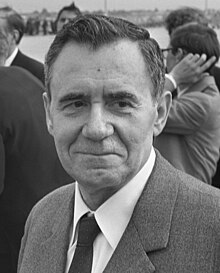
Back Andrei Gromiko Afrikaans Andrei Gromyko AN أندري جروميكو Arabic اندرى جروميكو ARZ Andréi Gromyko AST Громыко, Андрей Андреевич AV Andrey Qromıko Azerbaijani Громыко Андрей Андреевич Bashkir Андрэй Андрэевіч Грамыка Byelorussian Андрэй Грамыка BE-X-OLD
Andrei Andreyevich Gromyko (Russian: Андрей Андреевич Громыко; Belarusian: Андрэй Андрэевіч Грамыка; 18 July [O.S. 5 July] 1909 – 2 July 1989)[2] was a Soviet politician and diplomat during the Cold War. He served as Minister of Foreign Affairs (1957–1985) and as Chairman of the Presidium of the Supreme Soviet (1985–1988). Gromyko was responsible for many top decisions on Soviet foreign policy until he retired in 1988. In the 1940s, Western pundits called him Mr Nyet ("Mr No"), or Grim Grom, because of his frequent use of the Soviet veto in the United Nations Security Council.[3]
Gromyko's political career started in 1939 in the People's Commissariat for Foreign Affairs (renamed Ministry of Foreign Affairs in 1946). He became the Soviet ambassador to the United States in 1943, leaving that position in 1946 to become the Soviet Permanent Representative to the United Nations in New York. Upon his return to Moscow he became a Deputy Minister of Foreign Affairs and later First Deputy Minister of Foreign Affairs. He went on to become the Soviet ambassador to the United Kingdom in 1952.
As Foreign Minister of the Soviet Union, Gromyko was directly involved in deliberations with the Americans during the Cuban Missile Crisis and helped broker a peace treaty ending the 1965 Indo-Pakistani War. Under the leadership of Leonid Brezhnev, he played a central role in the establishment of détente with the United States by negotiating the ABM Treaty, the Partial Nuclear Test Ban Treaty and the SALT I & II, among others. When Brezhnev suffered a stroke in 1975 impairing his ability to govern, Gromyko effectively dictated policymaking alongside KGB Chairman Yuri Andropov, Defense Minister Andrei Grechko and Grechko's successor, Marshal Dmitry Ustinov. Even after Brezhnev's death, Gromyko's rigid conservatism and distrust of the West continued to dominate the Soviet Union's foreign policy until Mikhail Gorbachev's rise to power in 1985.
Following Gorbachev's election as General Secretary, Gromyko lost his office as foreign minister and was appointed to the largely ceremonial post of Chairman of the Presidium of the Supreme Soviet of the USSR. Subsequently, he retired from political life in 1988, and died the following year in Moscow.
- ^ Соседи по парте (in Russian). RPP. Archived from the original on 10 March 2010. Retrieved 11 September 2010.
- ^ Profile of Andrei Gromyko
- ^ Schmemann, Serge (4 October 1982). "Russians Come and Go, but Not Gromyko". The New York Times.
